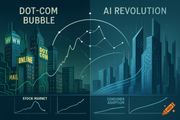Recent headlines, sparked by comments from OpenAI CEO Sam Altman, have reignited the debate: Are we in an AI bubble? While stocks briefly dipped and pundits declared the boom was over, a closer look at the data, the context, and the technology itself tells a much more nuanced story. This isn't just about market speculation; it's about the fundamental technology that will shape the coming years.
Here are eight key points to consider before buying into the bubble hype.
What Sam Altman Really Said
First, let's clarify what Sam Altman actually said. He didn't state that "AI is a bubble." In an interview, he noted that investors are "overexcited about AI." This is a crucial distinction. He pointed to a "kernel of truth" that smart people are getting excited about, while acknowledging the surrounding investment frenzy.
When asked if investors are overexcited, Altman's opinion was "yes." When asked if AI is the most important thing to happen in a very long time, his opinion was "also yes."
His observation is hardly surprising. Altman has had a front-row seat to this "overexcitement." His former chief scientist, Ilya Sutskever, left to form Safe Superintelligence, a company valued at $32 billion with no product. His former CTO, Mira Murati, now runs Thinking Machines Lab, valued at $12 billion, also with no public product. Altman's comments seem less like a condemnation of AI's potential and more like a candid observation of a venture capital market running hot.
The Media's Cry Wolf Problem
The media has been predicting an AI bubble for years. A year ago, outlets questioned if OpenAI could justify its valuation, suggesting its revenue targets were overstated.
- Prediction vs. Reality (Revenue): The Wall Street Journal noted OpenAI hoped to double its $2 billion revenue to $4 billion by 2025. In reality, as of August 2025, OpenAI has hit $12 billion in annualized revenue.
- Prediction vs. Reality (Users): The Washington Post dismissed early reports of 100 million users as mere "website visits." Today, ChatGPT has over 700 million weekly active users.
Time and again, pessimistic predictions have been dwarfed by reality. While analogies to the dot-com bubble are tempting, the underlying products and revenue streams in AI are proving far more substantial than pets.com.
Dissecting the "No ROI" Studies
Two recent studies from McKinsey and MIT have been widely cited as proof that AI investments aren't paying off. However, the details matter.
- The McKinsey Study: This report, which found that 8 in 10 enterprises see no measurable profit from AI, was conducted in mid-2024, before the new "reasoning paradigm" of models truly took hold. Furthermore, the report reads heavily like an advertisement for McKinsey's own AI consulting services, which coincidentally helped the successful companies it profiled.
- The MIT Study: This more thorough report found that while large, top-down corporate AI initiatives often fail, individual employees are achieving massive productivity gains through personal tools. This phenomenon, dubbed "shadow AI," creates a huge, often unmeasured "consumer surplus." The value you get from using AI tools—what you would pay to not have them taken away—is estimated to be in the hundreds of billions of dollars, a value not captured in traditional GDP metrics.
The Deception of Incremental Progress
Watching AI develop week-to-week can feel like a series of small, incremental steps. A new image editing feature here, a slightly better benchmark score there. However, if you zoom out and look at the progress year-over-year, the picture is one of explosive, almost unbelievable growth.
Just a year ago, the academic consensus was that models couldn't truly reason. Today, models like OpenAI's O1 preview have demonstrated abstract reasoning capabilities that were thought to be years away. In March, AI officially passed the Turing Test, with humans unable to distinguish conversations with GPT-4.5 from those with other humans. From lifelike speech generation to world-simulation models like Genie 3, the annual leaps are staggering.
Conclusion: Bubble, Boom, or Something Else?
While investor excitement is undeniably high and some valuations are frothy, labeling the current AI landscape as a mere "bubble" is an oversimplification. The underlying technology is progressing at a historic rate, generating real revenue, creating enormous user value, and solving problems once thought to be insurmountable. The media is contradictory, the CEOs are often unreliable narrators, but the technological progress is real and accelerating. The coming months will undoubtedly bring both market corrections and new, mind-bending capabilities.
标题:AI 正处于泡沫之中吗?山姆·奥特曼的真实言论与事实对比
摘要:
深入探讨关于 AI 泡沫的争论,澄清山姆·奥特曼关于“投资者过度兴奋”的真实言论,剖析关键的麻省理工学院和麦肯锡报告,并揭示为何媒体对即将到来的崩溃的叙述,忽略了前所未有的技术进步这一更宏大的图景。
内容:
最近,由OpenAI首席执行官山姆·奥特曼的评论引发的头条新闻再次点燃了这场辩论:我们是否正处于一个人工智能(AI)泡沫中?尽管股市短暂下跌,专家们宣称繁荣已经结束,但仔细审视数据、背景和技术本身,会发现一个更为微妙的故事。这不仅关乎市场投机,更关乎将塑造未来几年的基础技术。
在相信泡沫炒作之前,这里有八个关键点需要考虑。
山姆·奥特曼到底说了什么
首先,让我们澄清一下山姆·奥特曼的真实言论。他并没有说“AI是一个泡沫”。在一次采访中,他指出投资者“对AI过度兴奋”。这是一个至关重要的区别。他指出了一个聪明人正为之兴奋的“真相核心”,同时也承认了周围的投资狂热。
当被问及投资者是否过度兴奋时,奥特曼的观点是“是的”。当被问及AI是否是很长一段时间以来发生的最重要的事情时,他的观点是“也是的”。
他的观察并不令人意外。奥特曼对这种“过度兴奋”有着第一手的观察。他的前首席科学家伊尔亚·苏茨克维尔(Ilya Sutskever)离开并创立了Safe Superintelligence,一家在没有产品的情况下估值达到320亿美元的公司。他的前首席技术官米拉·穆拉蒂(Mira Murati)现在执掌Thinking Machines Lab,估值为120亿美元,同样没有公开产品。奥特曼的评论似乎与其说是对AI潜力的谴责,不如说是对一个过热的风险投资市场的坦率观察。
媒体的“狼来了”问题
多年来,媒体一直在预测AI泡沫。一年前,有媒体质疑OpenAI是否能证明其估值的合理性,暗示其收入目标被夸大了。
- 预测 vs. 现实(收入):《华尔街日报》指出,OpenAI希望在2025年前将其20亿美元的收入翻倍至40亿美元。而实际上,截至2025年8月,OpenAI的年化收入已达到120亿美元。
- 预测 vs. 现实(用户):《华盛顿邮报》曾将早期关于1亿用户的报道斥为仅仅是“网站访问量”。如今,ChatGPT每周活跃用户已超过7亿。
悲观的预测一次又一次地被现实所超越。尽管与互联网泡沫进行类比很诱人,但AI领域的基础产品和收入流正被证明比pets.com要坚实得多。
剖析“无投资回报”的研究
最近,两份来自麦肯锡和麻省理工学院的研究被广泛引用,作为AI投资没有回报的证据。然而,细节至关重要。
- 麦肯锡研究:这份报告发现,十分之八的企业没有从AI中看到可衡量的利润,但它是在2024年中期进行的,那时模型的新“推理范式”尚未真正确立。此外,该报告读起来很像麦肯锡自家AI咨询服务的广告,而它所介绍的成功公司恰好得到了麦肯锡的帮助。
- 麻省理工学院研究:这份更详尽的报告发现,尽管大型、自上而下的企业AI项目常常失败,但个人员工通过使用个人工具正在实现巨大的生产力提升。这种被称为**“影子AI”**的现象,创造了一个巨大且通常无法衡量的“消费者剩余”。你从使用AI工具中获得的价值——即你愿意支付多少钱来避免它们被夺走——估计高达数千亿美元,这一价值并未被传统的GDP指标所捕捉。
渐进式进步的欺骗性
周复一周地观察AI的发展,可能会感觉像是一系列微小的、渐进的步骤。这里有一个新的图像编辑功能,那里有一个稍微好一点的基准测试分数。然而,如果你拉远视角,审视年复一年的进步,你会看到一幅爆炸性、几乎令人难以置信的增长图景。
就在一年前,学术界的共识是模型无法真正进行推理。如今,像OpenAI的O1预览版这样的模型已经展示出被认为需要数年才能实现的抽象推理能力。今年三月,AI正式通过了图灵测试,人类无法区分与GPT-4.5的对话和与其他人类的对话。从逼真的语音生成到像Genie 3这样的世界模拟模型,每年的飞跃都令人震惊。
结论:泡沫、繁荣,还是别的什么?
尽管投资者的热情无疑是高涨的,一些估值也存在泡沫,但将当前的AI格局简单地标记为“泡沫”是一种过度简化。其底层技术正以前所未有的速度发展,创造着真实的收入、巨大的用户价值,并解决着一度被认为无法克服的问题。媒体的报道是矛盾的,CEO们常常是不可靠的叙述者,但技术进步是真实且在加速的。未来几个月无疑将同时带来市场调整和全新的、令人震撼的能力。
